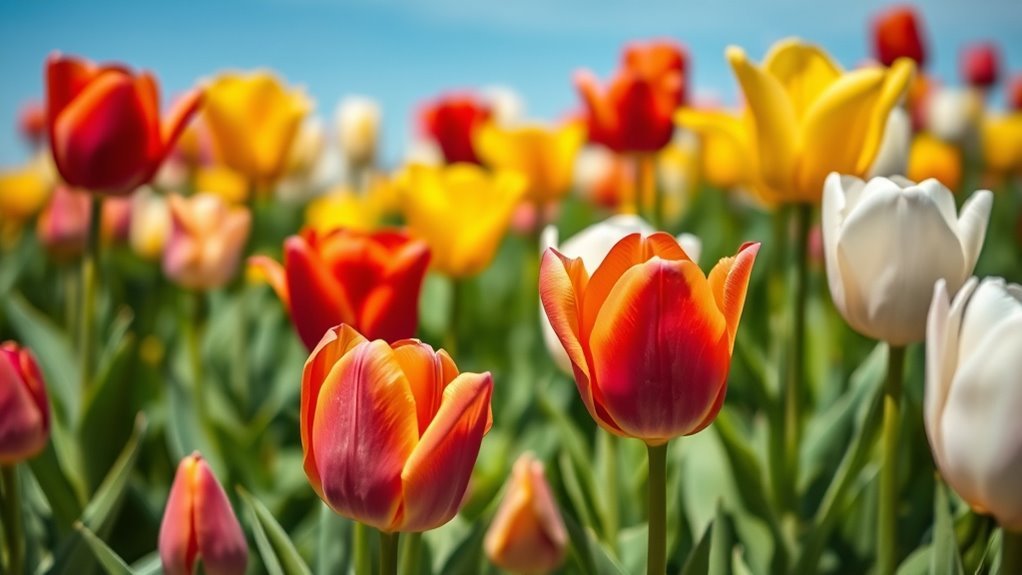11 Spiritual Meanings of Tulip Flower Color
When you see tulips, notice their bright colors. Each color has a meaning that connects with your feelings. Red tulips represent passion, while pink tulips offer warmth. Think about what these colors might say about your emotions and relationships. What story do the tulips tell about your heart's journey?
Key Takeaways
- Red tulips represent love and passion, embodying deep emotional connections and authentic relationships.
- Pink tulips symbolize care and affection, highlighting kindness and strengthening cherished bonds.
- Yellow tulips denote cheerfulness and happiness, encouraging positivity and appreciation for life's beauty.
- White tulips reflect purity and forgiveness, promoting fresh starts and emotional healing.
- Purple tulips signify royalty and elegance, expressing admiration and adding sophistication to special occasions.
Red Tulips: Symbol of Love and Passion
Red tulips are vibrant flowers that symbolize love and passion. Their bright color draws attention and evokes strong emotions.
These flowers are more than just decorations; they express feelings and convey messages of romance. Gifting red tulips enhances the meaning of love and connects to rich history and culture.
Each petal represents deep personal connections, inviting you to share your true feelings. In a time when authenticity matters, red tulips stand out as powerful symbols of love.
They represent the passion you want to spark and nurture in your relationships, resonating with feelings that touch the heart.
Pink Tulips: Expression of Care and Affection
Pink tulips are beautiful flowers that symbolize care and affection. Each petal opens like a warm hug, expressing kindness and compassion.
When you give pink tulips as gifts, you share a heartfelt message that says, "I see you, and I care." These flowers are elegant and help strengthen bonds in cherished relationships.
Imagine placing a bouquet on a loved one's table. Each glance at the flowers reminds them of your shared affection. In a busy world, pink tulips highlight the beauty of connection and invite you to express the love you feel.
They're a simple yet powerful way to show you care.
Yellow Tulips: Sign of Cheerfulness and Happiness
Yellow tulips bring joy and happiness. Their bright colors remind us of warm, cheerful moments and celebrations. They symbolize hope and encourage us to appreciate life's beauty.
Here are some thoughts on what yellow tulips represent:
- Brighten your day with positivity.
- Share laughter and create memories.
- Foster an encouraging environment.
- Appreciate friendships and connections.
Each yellow tulip carries a promise of joy.
Let their cheerful spirit inspire your happiness, reminding you that every moment can be filled with beauty.
White Tulips: Emblem of Purity and Forgiveness
White tulips symbolize purity and forgiveness. Their delicate petals can reflect a desire for clarity amid life's challenges.
Each bloom offers a promise: a fresh start and a reminder that forgiveness is a journey, not just an end point. Caring for these flowers in your heart can help you see how letting go can brighten paths once hidden in darkness.
Purple Tulips: Representation of Royalty and Elegance
Purple tulips symbolize royalty and elegance. Their rich colors bring beauty and grace to any space. When you choose these flowers, you connect with the idea of inner nobility.
You can use purple tulips in these ways:
- Special occasion arrangements add sophistication.
- Bouquets for loved ones express appreciation and honor.
- Home decor with these blooms creates a peaceful, luxurious feel.
- Gifts for milestones show respect and admiration.
Each tulip conveys that elegance can thrive in simple gestures, fostering a sense of belonging.
Orange Tulips: Symbol of Desire and Enthusiasm
Orange tulips bring a burst of energy and symbolize desire and enthusiasm. Their vibrant colors radiate warmth and encourage you to recognize your inner passion.
In tulip symbolism, orange prompts action, sparks motivation, and ignites creativity. It suggests potential and encourages you to chase your dreams.
Color psychology indicates that orange fosters connection and promotes joy and friendship.
As you enjoy this bright color, remember that desire fuels growth, and enthusiasm strengthens relationships. Let the spirit of orange tulips inspire you to build connections and develop a sense of community in your life.
Blue Tulips: Sign of Tranquility and Peace
Blue tulips are rare flowers that symbolize peace and tranquility. Their delicate petals bring calmness and serve as reminders of serenity.
When you hold blue tulips, consider these key points:
- Inner Peace: They promote reflection and meditation.
- Emotional Balance: Blue tulips foster harmony in relationships.
- Hope and Healing: Their soothing color supports emotional recovery.
- Connection to Nature: They represent unity and a sense of belonging.
As you think about blue tulips, you may find comfort.
Let their beauty guide you towards a peaceful state, allowing you to release stress and embrace tranquility.
Black Tulips: Emblem of Mystery and Power
Black tulips are symbols of mystery and power. They invite you to explore your deeper self. Unlike blue tulips that offer peace, black tulips encourage strength and resilience. They call you to face the unknown and appreciate the beauty in shadows.
When you see black tulips, you may feel inspired. They motivate you to harness your inner strength and confront life's challenges. Black tulips show that growth comes from understanding both light and dark.
In their presence, you can feel a sense of belonging. They blend mystery with personal power, urging you to rise and grow.
Bi-Color Tulips: Symbol of Diversity and Unity
Bi-color tulips add vibrant color to any garden. They show the beauty of diversity and the strength found in unity. When you choose these flowers, consider their meaning. In many cultures, they symbolize togetherness.
Here are some gardening tips to reflect this idea:
- Mix colors: Plant different bi-color tulips together for a harmonious look.
- Companion plants: Include flowers that bloom at the same time for a full display.
- Seasonal planting: Change colors each season to show the changing nature of unity and diversity.
- Shared space: Create communal garden areas to promote appreciation and connection.
Each bloom represents both uniqueness and belonging. Enjoy the beauty they bring!
Green Tulips: Representation of Growth and Renewal
Green tulips have fresh colors that represent growth and renewal in gardens. They invite you to reflect on your journey and explore new possibilities.
Their vibrant shades symbolize how challenges can strengthen your spirit and lead to transformation. You may feel connected as these flowers remind you that every season brings change and potential.
Each petal marks a step toward new beginnings, encouraging you to let go of what you no longer need. Their beauty can awaken your soul, renewing your hope and passion for life.
Trust in your journey; growth is your promise.
Lavender Tulips: Sign of Spirituality and Calmness
Lavender tulips bring a sense of calm and peace. Their delicate blooms hold spiritual meaning, guiding you to inner tranquility.
- Symbol of calmness: Lavender tulips create a peaceful mindset.
- Encouragement for reflection: They promote self-examination and mindfulness.
- Connection to spirituality: These flowers remind you of your personal journey.
- Emotional healing: Their presence aids in emotional growth and recovery.
As you enjoy lavender tulips, allow their soothing nature to clear your thoughts.
Let them help you create a space of belonging and comfort.
Frequently Asked Questions
What Is the Origin of Tulip Flower Symbolism?
Tulip symbolism has deep historical roots and mythological connections. These flowers represent love and beauty through various stories and legends. Each tale invites you to explore themes of connection and shared experiences, enriching your understanding of what tulips symbolize.
How Do Tulip Colors Vary in Different Cultures?
Tulip colors carry different meanings in various cultures. In many countries, red tulips represent love. Yellow tulips often symbolize cheerfulness in others. Understanding these flower meanings can help connect people across cultures. Enjoy discovering how tulip colors enrich our experiences and feelings.
Can Tulips Be Used in Spiritual Rituals?
Tulips can be used in spiritual rituals to enhance your flower meditation. Picture each petal offering insights from nature. These flowers can help you reflect, heal, and find peace in their beauty. Using tulips can strengthen your connection to nature and enrich your meditation experience.
Are Tulips Associated With Any Specific Religious Beliefs?
Tulips are symbols of renewal and hope in many religious beliefs. Their beauty represents a connection to something greater. Many cultures find meaning in tulips, valuing their role in expressing faith and unity.
What Are the Best Ways to Care for Tulips Spiritually?
To care for tulips spiritually, practice tulip meditation. Let their bright colors inspire your heart and mind. Use their energy to heal and nurture both your garden and your spirit. Focus on building stronger connections with nature and yourself. Spend time in your garden, appreciating the beauty of tulips and the joy they bring.

Liza Stockholm is an esteemed spiritual guide and the visionary behind Spiritual with Liza. With a profound passion for empowering others on their spiritual journey, Liza offers a blend of educational content and personal guidance. Her expertise in spirituality is rooted in years of dedicated practice and study, making her a trusted companion for those seeking enlightenment and inner peace.











